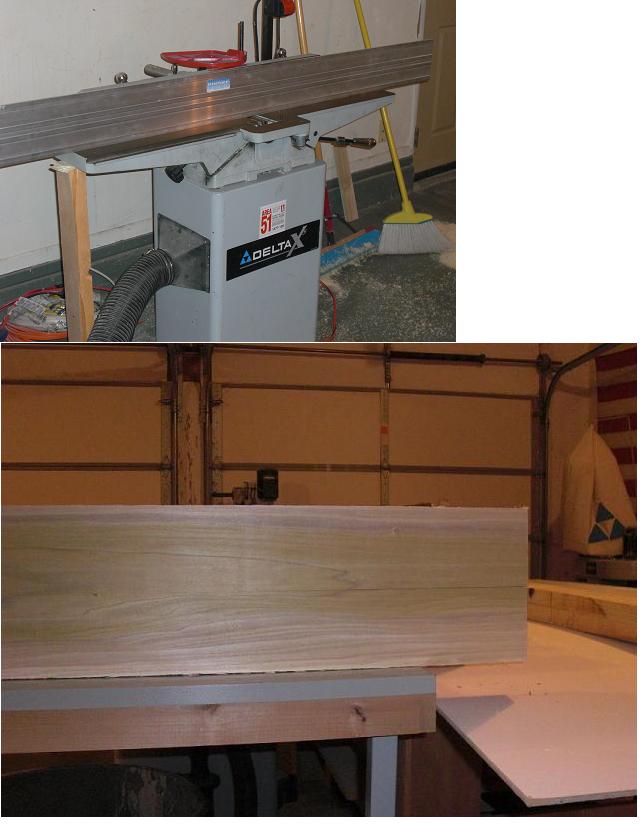Question
I have a 6” Delta jointer that has never provided a truly straight jointed board on any board longer than 24”. My intent for this post is to lay out how my jointer is setup; illustrates the results of a jointed 24” board, and ask for your advice on what might be causing the problem (me or the machine.)
Below is a picture of my Delta jointer with an extremely accurate straight-edge spanning the in-feed and out-feed tables. Using the straight-edge and some automotive feeler gauges, I’ve measured the tables for flatness. Both tables have areas that are .006 out of flatness.
Question 1: Is .006 an acceptable tolerance for a jointer bed? Looking at the image, surely you’ve noticed the 2x4 and paper wedges propping the out-feed table up. Using this board is the only way I can get the two tables in a co-plane. Without that board, no amount of gib-screw adjusting or shimming will prop up the end of the out-feed table to be in plane with the in-feed table. I’ve had to resort to this method to keep the table accurate; however, the tables are close to a co-plane, but are out be .002 at the in-feed tables end. So even using this method does not make the jointer accurate.
Question 2: Is this a common problem with “dovetail style jointer”? The second image shows how accurate the jointed is. When I take two pieces of wood, approximately 3’ each, and joint their edges back-to-back, the results are illustrated in the image. The middle 12” of the joint are perfect, but the outer 12” at both ends are not accurate. I’m confident that the jointer blade height is not causing the problem because I use a Starrett dial indicator to get them within .001 of the out-feed table.
So my overall question: Am I being too picky for accurate tolerances with this jointer or is the equipments listed issues causing the problem? Are the tolerances poor enough the Delta would consider replacing the machine, or am I crazy to think they would ever consider it? I’ve grown tired of dealing with it, as it makes building inset door almost impossible. Please let me know your advice.

Forum Responses
(Solid Wood Machining Forum)
From contributor U:
If you can't adjust the infeed table to match the outfeed, then you might try to get it replaced (or just sell it and get another one). Rather than trying to measure the outfeed table to cutterhead relationship, I have found that if you start with the outfeed too low, then raise it until the snipe just disappears on test cuts, that is where it needs to be.
Jointing long boards is very technique dependent. Make sure that most of your pressure is on the outfeed side after the cut is started.
Even when everything is working perfectly, the blades are cutting in little arcs, creating a (however finely) rippled surface with valleys (the top of the arc of the blade) and peaks (the ridges between cuts). It's the ridges that ride on the outfeed table, not the valleys.
Your feed rate also matters; if you run the workpiece over the jointer quickly, the cut arcs are further apart, and the distance between peaks and valleys is larger; faster feed rates demand (at least theoretically) that the outfeed table be lower than for slow feed rates. If your blades are at all dull and cause the workpiece to vibrate and jump up a hair as it moves past the cutterhead then, again, the surface produced is not quite where you'd expect it to be, and the outfeed table needs to be a hair lower. You've run over a knot, and now a chip in the blade produces a raised line on the cut surface? Again, the outfeed table needs to be lower to compensate.
What all this boils down to is that a dial indicator is not very useful in setting the height of the outfeed table because it relies on a simplistic understanding of where that table really needs to be. Instead, do as contributor U suggested. Set the outfeed intentionally low, take test cuts and raise it in small increments until the snipe at the end of the cut just barely disappears, and you're done.
Finally, these guys are also correct that a perfect setup can be thwarted by operator error in running the boards over the jointer. Look first at the shape of the edge and decide if you want to joint the hollow edge or the crowned edge. Either shape can be jointed but require different techniques. Feed speed and where you push and apply pressure affect the outcome as well as board length.
To me, an acceptable joint is gap free - no light shining through between two boards as long as the outfeed table. If the outfeed table is concave, you will never achieve that result; if it's convex, you may be able to get close to it. It is probably not worth the time/money to repair the tables on this machine, but it is possible to re-machine or hand scrape them to an acceptable tolerance, and adjust the gibs or shim them into coplanarity. The other posters are correct about adjusting outfeed table height and using good technique, but if the tables, particularly the outfeed table, are really that far out of whack you may be beating a dead horse.